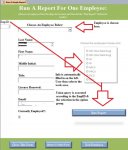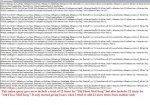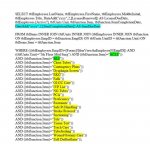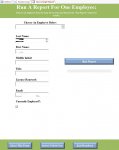Apparently, I've hit a 255 character limit with my previous union queries. So my next thought was to break up the union queries into smaller chunks & have an option group invoke a specific query which is also filtered by the EmpID field on the same form.
Here's what I mean: the "frmViewAnEmployee" attachment shows just one of the forms that I'm trying to do this on. Originally, the "Run Report" command button was supposed to execute "qrySingleReport (a union query)" according to which employee you chose in the combo box (combo box is tied to the EmpID). This worked perfectly until I tried to expand the union query even further.
So I divided the union query into smaller chunks & added an option group to the form. My thought is this: user selects the employee from the combo box, the EmpID field is automatically filled in by this, the user then clicks on the option that designates which work area (unit) the employee is from, & then clicks the command button to get the filtered results. Is this possible without VBA? If not, how do I go about it? Thank you.
Here's what I mean: the "frmViewAnEmployee" attachment shows just one of the forms that I'm trying to do this on. Originally, the "Run Report" command button was supposed to execute "qrySingleReport (a union query)" according to which employee you chose in the combo box (combo box is tied to the EmpID). This worked perfectly until I tried to expand the union query even further.
So I divided the union query into smaller chunks & added an option group to the form. My thought is this: user selects the employee from the combo box, the EmpID field is automatically filled in by this, the user then clicks on the option that designates which work area (unit) the employee is from, & then clicks the command button to get the filtered results. Is this possible without VBA? If not, how do I go about it? Thank you.










